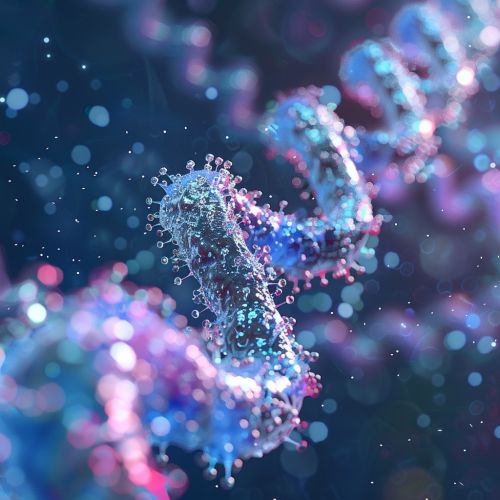Reverse transcription
Overview
Reverse transcription is a biological process where RNA is converted into DNA. This process is catalyzed by the enzyme reverse transcriptase. The newly formed DNA molecule can then be integrated into the host genome or exist as an extrachromosomal element (plasmid, episome) in the host organism. Reverse transcription is a central part of the replication cycle of retroviruses, including HIV.


Mechanism of Reverse Transcription
The process of reverse transcription begins with the binding of reverse transcriptase to a specific region on the RNA molecule. This region is known as the primer binding site (PBS). The PBS is complementary to the 3' end of the tRNA molecule, which serves as the primer for reverse transcription.
Once the primer is bound to the PBS, reverse transcriptase begins to synthesize DNA by adding deoxyribonucleotides (dNTPs) to the 3' end of the primer. This process continues until the entire RNA molecule has been reverse transcribed into DNA.
The newly synthesized DNA molecule then undergoes a process known as strand transfer, where it is transferred to another region of the RNA molecule. This region is known as the repeat (R) region. The R region is identical to the PBS and is located at both ends of the RNA molecule.
Following strand transfer, the DNA molecule is extended further by reverse transcriptase. This process continues until the entire RNA molecule has been reverse transcribed into a double-stranded DNA molecule.
Role in Retroviruses
Reverse transcription is a key step in the life cycle of retroviruses. Retroviruses are a group of RNA viruses that replicate in a host cell by reverse transcription. The reverse transcription process in retroviruses is similar to that described above, with some additional steps.
In retroviruses, the reverse transcription process begins with the binding of reverse transcriptase to the viral RNA molecule. This binding is facilitated by a specific protein known as nucleocapsid protein (NC). The NC protein binds to the PBS on the viral RNA molecule and recruits reverse transcriptase to the site.
Once reverse transcriptase is bound to the viral RNA molecule, it begins to synthesize DNA. This process is similar to the one described above, with the addition of a few extra steps. These extra steps include the removal of the original RNA molecule by an RNase H activity of the reverse transcriptase and the synthesis of a second DNA strand.
The newly synthesized DNA molecule is then integrated into the host genome by a viral enzyme known as integrase. This process is known as viral integration. Once integrated, the viral DNA molecule can be transcribed and translated by the host cell machinery, leading to the production of new virus particles.
Applications in Molecular Biology
Reverse transcription has several applications in molecular biology. One of the most common applications is in the synthesis of complementary DNA (cDNA) from an RNA template, a process known as reverse transcription polymerase chain reaction (RT-PCR). This technique is widely used in gene expression studies to convert mRNA into DNA.
Another application of reverse transcription is in the creation of cDNA libraries. These libraries are collections of cDNA molecules that represent the mRNA population of a particular cell or tissue type. cDNA libraries are useful for studying gene expression patterns and for identifying and cloning genes.
Reverse transcription is also used in the detection and quantification of RNA viruses. By converting the RNA genome of a virus into DNA, researchers can use PCR techniques to detect and quantify the presence of the virus. This technique is commonly used in the diagnosis of viral infections such as HIV and hepatitis C.
